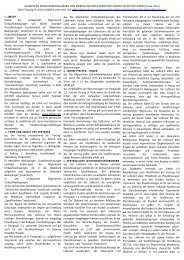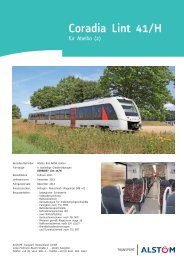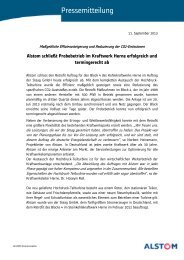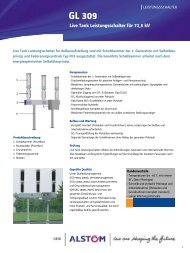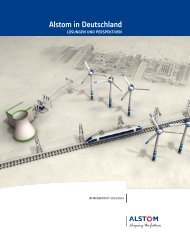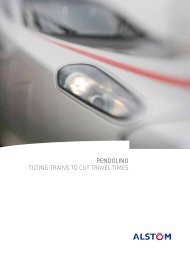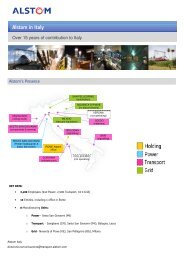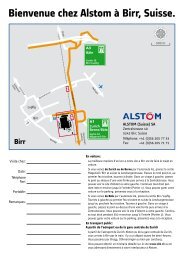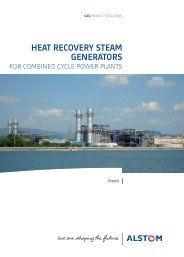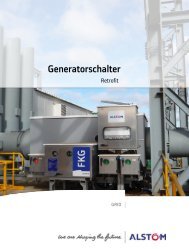MOROCCO IS ACCELERATING! feature - Alstom
MOROCCO IS ACCELERATING! feature - Alstom
MOROCCO IS ACCELERATING! feature - Alstom
Create successful ePaper yourself
Turn your PDF publications into a flip-book with our unique Google optimized e-Paper software.
30<br />
society<br />
�<br />
Complex worlds…<br />
Although new stations are being built, such<br />
as those along high-speed tracks, the great<br />
majority of French stations were designed<br />
and built according to a model of organisation<br />
dating from the nineteenth century. Adding<br />
on twenty-fi rst century services to this model<br />
is not easy. The paradox of rail is that<br />
it is a service industry which requires, right<br />
in the city centre, the production processes<br />
of heavy industry – track equipment,<br />
train depots, etc. – most of which also date<br />
from the nineteenth century and require large<br />
areas of space. “Modernising a station<br />
to provide fl uid and functional operations<br />
is incredibly complex in spatial engineering<br />
terms,” states Sophie Boissard.<br />
“This was the case with the Gare de Lyon,<br />
in Paris, where installing supply warehouses<br />
in the Charolais district required<br />
the conversion of former underground freight<br />
warehouses into cooking preparation<br />
centres.” When one talks about a station,<br />
the public often thinks of rails, electric cables,<br />
etc., but all this is in fact ‘only’ the rail<br />
infrastructure. The architect’s approach<br />
must be much wider, because the station,<br />
along with the train’s interior, is one of<br />
the two places where the passenger spends<br />
time, places that they assess in terms<br />
of comfort, atmosphere, service, and so on.<br />
It is therefore necessary to work<br />
The typology of French stations<br />
simultaneously on these two complementary<br />
worlds to increase their quality. This is a global<br />
process in which rail builders, operators<br />
and infrastructure managers are all concerned.<br />
It is the role of Gares & Connexions to create<br />
a systemic vision which federates these<br />
different actors. The entity was created by<br />
the SNCF, in 2009, to master the inherent<br />
complexity of the station world.<br />
Renovating a station becomes complicated<br />
when distinct traffi c fl ows are superimposed.<br />
“The Gare Paris-Nord, with its 180 million<br />
passengers each year, is an excellent<br />
example. It is distinguished by a very wide<br />
rail offer which includes the Eurostar<br />
(dedicated terminal, customs post…),<br />
the Thalys and the TGV Nord (which require<br />
services for passengers who are mainly<br />
business travellers), commuters who travel<br />
to work on the regional lines of the Paris<br />
area and the Ile-de-France (TER Picardie,<br />
Corail Intercités…). In addition, underground,<br />
there is the metro and the RER and,<br />
on the surface, individual forms<br />
of end of journey transport: taxis,<br />
limousines or hire cars, the Vélib’* bicycle,<br />
electric vehicles… And in the middle of all this,<br />
constantly developing ticket sales space,<br />
shops and service areas.” For the<br />
Managing Director of Gares & Connexions,<br />
successfully increasing the capacity<br />
to welcome passengers in a listed building<br />
full of constraints of all kinds, including �<br />
French stations are divided into 4 categories:<br />
• Major hubs served by the European rail network: 33 stations corresponding<br />
to the main French cities plus 6 huge Paris stations each receiving an average<br />
of 30 to 50 million passengers per year.<br />
• Stations on the high-speed network and conventional mainlines:<br />
about 90 stations.<br />
• Commuter stations: about 390 stations in the Ile-de-France,<br />
such as Versailles-Chantiers or Juvisy, which have a throughput<br />
of 20 to 30 million passengers per year.<br />
• Lastly, about 2,500 stations providing access to different categories<br />
of network (regional and, by connections, national or international).<br />
These include between 100 and 300 stations with substantial traffi c levels.<br />
* Velib: Paris’ cycle hire scheme.



